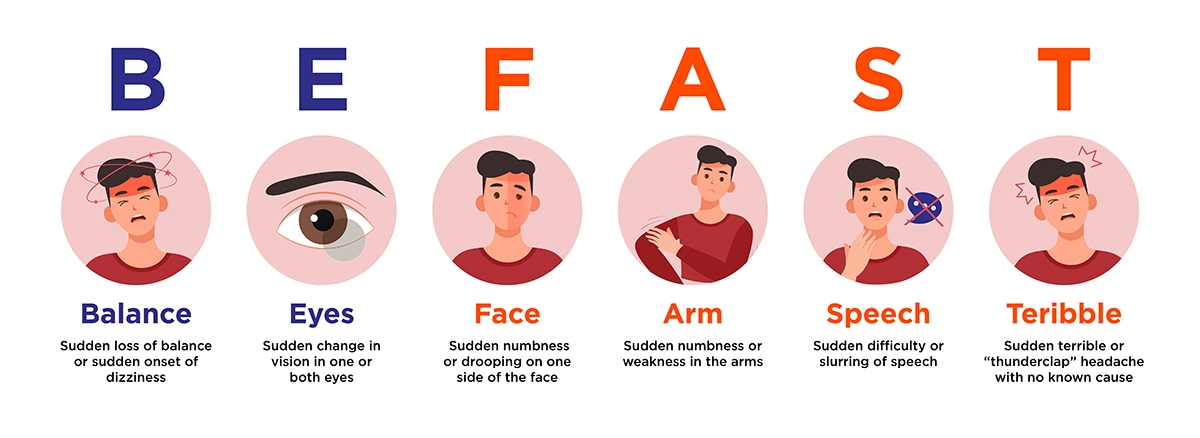Can Young Adults Have Strokes?

Researchers from the Centers for Disease Control and Prevention found that the prevalence of stroke among young adults (18-44 years) has increased by 10-15% in the last decade. This group experiences strokes due to several factors, including obesity, high blood pressure, diabetes, cholesterol, and unhealthy lifestyle habits, mainly smoking.
People with diabetes are twice as likely to have a stroke compared to people without diabetes. High sugar levels can damage blood vessels in various body parts, including the brain.
Other risk factors for stroke among young adults include an unhealthy diet, a sedentary lifestyle, and stress.
What is a stroke?
A stroke occurs when blood flow to an area of the brain is cut off; it is often called a “brain attack.” This prevents oxygen from reaching brain cells, causing brain cell death and potentially leading to permanent brain tissue damage.
The level of the damage depends on the size and type of stroke. Some people may experience only temporary weakness after a stroke, while others may suffer permanent disability or even death.
There are two types of strokes:
1. Ischemic stroke
Ischemic stroke occurs when blood flow and oxygen to the brain are interrupted, causing brain tissue damage. High blood pressure, heart disease, and significant atherosclerosis in blood vessels are common causes of this condition in older adults. Ischemic strokes account for 85% of all strokes, with 60% of cases occurring in people under the age of 50.
2. Hemorrhagic stroke
A hemorrhagic stroke occurs when a blood vessel in the brain ruptures, causing blood to leak into or around the brain and damage the surrounding brain tissue.
This condition is usually caused by hypertension or a malformation of the blood vessels in the brain. Heart attacks cause 15% of strokes, with 40% of them happening in those under the age of 50.
Stroke symptoms in young adults are similar to those of other stroke cases. To recognize a stroke, remember BEFAST.

Causes of stroke in young adults
1. Hypertension
Hypertension (high blood pressure) occurs when the blood pressure within the blood vessels is consistently above average. According to the American Heart Association (AHA), hypertension is diagnosed when systolic blood pressure is ≥140 mmHg and/or diastolic blood pressure is ≥90 mmHg on repeated measurement.
Healthy blood pressure is defined below 120/80 mm Hg.
2. Diabetes
People with diabetes are twice as likely to have a stroke as those without diabetes. To reduce this risk, people with diabetes must manage their blood glucose, blood pressure, cholesterol, and weight.
Diabetes prevents the body from processing food correctly, impairing insulin production or use. This leads to glucose (sugar) buildup in the blood.
Over time, high blood sugar levels can damage blood vessels in various parts of the body, including the brain, increasing the risk of stroke.
3. Obesity
Being overweight can increase the risk of stroke by 22%. However, if you are obese, the risk increases by 64%.
This is because being overweight increases the risk of high blood pressure, heart disease, high cholesterol, and type 2 diabetes – all of which contribute to improving the risk of stroke.
4. Heart disease
Conditions such as coronary heart disease, congenital heart disease, rheumatic heart disease, cardiomyopathy (decreased heart muscle function), deep vein thrombosis (DVT), and pulmonary embolism can increase the likelihood of stroke at a young age.
Heart rhythm disorders, especially atrial fibrillation (AF), increase the risk of stroke by five times.
5. Cholesterol
High cholesterol can lead to plaque buildup in blood vessels. If plaque breaks off and travels to the brain's blood vessels, it can cause a stroke. This type of stroke is called thromboembolism.
6. Smoking
Smoking increases the risk of stroke at any age. The World Stroke Organization reports that smoking 20 cigarettes per day raises the risk of stroke by six times.
In addition, the Centers for Disease Control and Prevention (CDC), highlights that passive smokers—those who do not smoke but are exposed to secondhand smoke—face a 25–30% higher risk of heart disease and a 20–30% higher risk of stroke.
Other risk factors
- Viral infections, such as HIV.
- Use of birth control containing estrogen.
- Pregnancy can cause the blood to clot more quickly, known as hypercoagulability. According to the AHA, strokes in pregnant women (ages 12-35) account for 18% of strokes in young women.
- Medical conditions that cause inflammation, such as lupus.
- Genetics and a family history of stroke.
- Use of certain medications, such as blood thinners, which can increase the risk of bleeding in the brain.
- Poor lifestyle choices, such as excessive alcohol and tobacco use, lack of physical activity, and a diet high in refined sugar and saturated fat.
Preventing high blood pressure in young adults

A healthy lifestyle can help lower high blood pressure. Here are some key steps:
- Manage your weight
- Exercise regularly (do 150 minutes of aerobic exercise weekly and 2-3 sessions of strength training)
- Eat a balanced diet: Fruits, vegetables, whole grains, and low-fat protein.
- Limit alcohol intake: No more than two drinks per day.
- Quit smoking.
- Reduce or manage stress, and get 7–9 hours of sleep per night.
**
With increasing research on cardiovascular disease and advances in medical technology, stroke recovery rates have improved.
However, every stroke patient does not recover immediately. Many stroke survivors may require long-term support and rehabilitation to improve their overall health.
The outlook for stroke patients varies. It depends on factors such as how quickly a person receives medical care, the severity of symptoms, and other medical conditions.
Remember, time is brain; the sooner a stroke is recognized, the faster the patient's recovery rate. Get to the nearest emergency department immediately before permanent damage occurs to the brain (<4.5 hours); every second is crucial.



